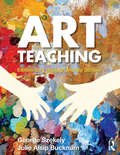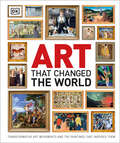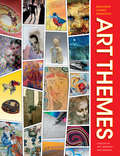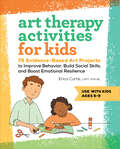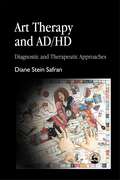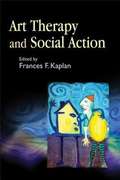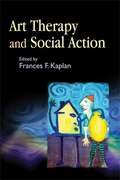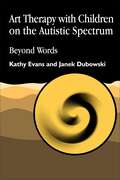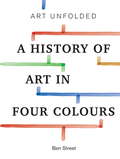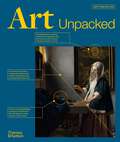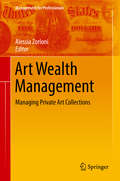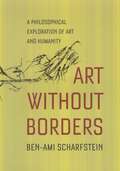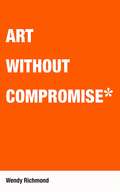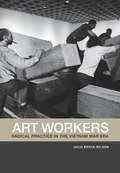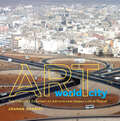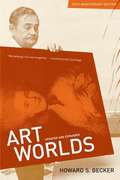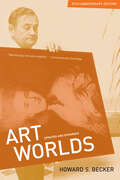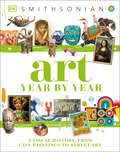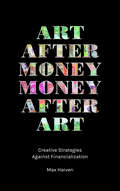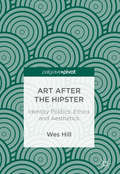- Table View
- List View
Art Teaching: Elementary through Middle School
by George Szekely Julie Alsip BucknamArt Teaching speaks to a new generation of art teachers in a changing society and fresh art world. Comprehensive and up-to-date, it presents fundamental theories, principles, creative approaches, and resources for art teaching in elementary through middle-school. Key sections focus on how children make art, why they make art, the unique qualities of children’s art, and how artistic development can be encouraged in school and at home. Important aspects of curriculum development, integration, evaluation, art room management, and professional development are covered. A wide range of art media with sample art activities is included. Taking the reader to the heart of the classroom, this practical guide describes the realities, challenges, and joys of teaching art, discusses the art room as a zone for creativity, and illustrates how to navigate in a school setting in order to create rich art experiences for students. Many textbooks provide information; this book also provides inspiration. Future and practicing teachers are challenged to think about every aspect of art teaching and to begin formulating independent views and opinions.
Art That Changed the World: Transformative Art Movements and the Paintings That Inspired Them (DK Timelines)
by DKThis is your A to Z guide to art! From cave paintings to pop art and modern masterpieces, this absorbing and beautiful art encyclopedia explores the development of art in spectacular detail. Here&’s what you&’ll find inside the pages of this visually stunning art book: • Covers every major movement in art from prehistory to the present day • Each movement is tracked in a visual timeline that showcases its key paintings and notable artists, and explains its context — the major events in its evolution • Each section ends with a stunning image of a masterwork and a curator's analysis that encapsulates its values, style, composition and subject matter • Glossary of technical terms and a comprehensive index Get ready to embark on a unique guided tour throughout the history of art. Get to know more than 700 of the greatest artists, from Michelangelo and Monet to Damien Hirst and Picasso. Discover 2,500 of the world&’s most iconic paintings, sculptures and other artwork that has shaken the art world through centuries and across continents. Truly comprehensive in scope, Art That Changed the World presents the most remarkable art movements throughout history in chronological order and explains the social and cultural background of each period. Turning-point paintings that triggered or epitomised each artistic movement are identified and explained, against a backdrop of influences — from admired techniques of an earlier artist to the changes in society that enabled new directions in art. A must-have for your bookshelf, this is an indispensable art reference book for art-lovers everywhere!
Art Themes: Choices in Art Learning and Making
by Marjorie Cohee ManifoldFlexible in approach and full of colorful examples, this textbook provides a basic introduction to what art is and can be in the lives of people who do not necessarily think of themselves as "artists." You will be taught about a variety of art themes, genres, materials, and processes that appeal to novice art makers. The lessons are organized by themes of general subject matter or media. Options are available for work in mixed media, crafts, photography and digital media, as well as in traditional drawing or painting media. After picking a theme of particular interest to you, look next at the four strands of lessons presented in that thematic unit. Moving from left to right, select one lesson from each consecutive strand and complete that lesson. Because each lesson builds upon previously presented knowledge and developed skill, as you progress through four lessons, one from each strand, you should grow in your understanding of art concepts, meanings, and processes, while also improving your art making skills. Completing this course will help you develop a new appreciation for the power and possibilities of art learning, by understanding better the art others create, as well as making it yourself.
Art Theory for a Global Pluralistic Age: The Glocal Artist
by Steven Félix-JägerThis book extends a theory of art that addresses the present era’s shift towards global pluralism. By focusing on extrinsic rather than intrinsic qualities of art, this book helps viewers evaluate art across cultural boundaries. Art can be universally classified by an evaluation of its guiding narrative, and can be understood and judged through hermeneutical methods. Since artists engage culture through various local, transnational, and emerging global narratives, it is difficult to decipher what standards are used for evaluation, and which authoritative body evaluates the work. This book implements a narrative-hermeneutical approach to properly classify an artwork and establish its meaning and value.
Art Theory: A Very Short Introduction
by Cynthia A. FreelandIn today's art world, many strange, even shocking, things qualify as art. In this Very Short Introduction Cynthia Freeland explains why innovation and controversy are valued in the arts, weaving together philosophy and art theory with many fascinating examples. She discusses blood, beauty, culture, money, museums, sex, and politics, clarifying contemporary and historical accounts of the nature, function, and interpretation of the arts. Freeland also propels us into the future by surveying cutting-edge web sites, alongside the latest research on the brain's role in perceiving art. This clear, provocative book engages with the big debates surrounding our responses to art and is an invaluable introduction to anyone interested in thinking about art.
Art Therapy Activities for Kids: 75 Evidence-Based Art Projects to Improve Behavior, Build Social Skills, and Boost Emotional Resilience
by Erica Curtis LMFT, ATR-BCBuild social-emotional skills with art therapy activities for kids ages 6 to 9 Making art is a great way for kids to sort through their emotions and learn how to solve problems in creative ways. This standout choice among art therapy books for kids is filled with activities for you and your child, whether you're looking for a fun weekend activity with high social-emotional value or you need in-the-moment strategies for resolving conflict. Together, you'll learn how to harness the power of art to soothe worries, get organized, ease transitions, and much more! Lots of ways to get creative—Explore projects organized by artform: drawing and painting, building and sculpting, cutting and pasting, dancing and music making, and acting and storytelling. Art therapy activities made easy—Each activity includes a list of materials, step-by-step instructions, and helpful tips. Keep an eye out for discussion questions to inspire deeper conversations with your child! Simple materials—There's no need to buy fancy or expensive materials for these activities! You might even have most of them on hand, like paper, pens, construction paper, and a device to play music. Encourage good behavior and help your child thrive with Art Therapy Activities for Kids!
Art Therapy and AD/HD: Diagnostic and Therapeutic Approaches
by Diane SafranAttention Deficit/Hyperactivity Disorder is increasingly being diagnosed in people of all ages, and this book demonstrates how art therapy can not only assist with diagnosis, but also provides a valuable means of helping to improve skills such as concentration and focus, boost self-esteem, and cope with impulsivity. Educational social skills art groups can help with understanding of AD/HD in addition to teaching strategies to relieve the symptoms. Art therapy is also important for alleviating feelings of isolation and confusion that may come with the diagnosis, and, as an ongoing process, it can be a useful tool for checking clients' progress from the initial assessment onwards. In the first part of her book, the author explores ways of using art therapy and of setting up art therapy groups. Her advice and practical suggestions will be useful to anyone with an interest in AD/HD. The later chapters offer therapists more detailed guidance on therapy sessions with clients with AD/HD. Practical and informative, and based on the author's long experience with art therapy and AD/HD, this will be a valuable book for therapists, mental health professionals, and people who live or work with AD/HD.
Art Therapy and Social Action
by Michael Franklin Pat Allen Frances F. Kaplan Edward Ned Bear Susan Berkowitz Lani Alaine Gerity David GussakArt Therapy and Social Action is an exciting exploration of how professionals can incorporate the techniques and approaches of art therapy in their work to address social problems. Examining the expanding role of art practitioner as social activist, leading art therapists and other professionals show how creative methods can be used effectively to resolve conflicts, manage aggression, heal trauma and build communities. The contributors provide examples of innovative programs on a range of topics, including those designed to address gun crime, homelessness, racism and experiences of terrorism, among others. This timely book provides new techniques and successful models for art therapists, counselors and mental health practitioners working directly with the challenges of modern society.
Art Therapy and Social Action: Treating the World's Wounds
by Maxine Borowsky Junge Pat Allen Edward Ned Bear Susan Berkowitz Frances KaplanArt Therapy and Social Action is an exciting exploration of how professionals can incorporate the techniques and approaches of art therapy in their work to address social problems. Examining the expanding role of art practitioner as social activist, leading art therapists and other professionals show how creative methods can be used effectively to resolve conflicts, manage aggression, heal trauma and build communities. The contributors provide examples of innovative programs on a range of topics, including those designed to address gun crime, homelessness, racism and experiences of terrorism, among others. This timely book provides new techniques and successful models for art therapists, counselors and mental health practitioners working directly with the challenges of modern society.
Art Therapy with Children on the Autistic Spectrum: Beyond Words
by Janek Dubowski Kathy EvansRecent research has shown that art therapy can be particularly effective for children with autism and related communication disorders. The extensive range of symptoms experienced by autistic people makes them extremely individual in presentation, so any treatment used must be tailored to a range of varying needs. Art Therapy with Children on the Autistic Spectrum presents a new model of practice, which primarily focuses on communication difficulties. The authors describe how negative behaviours and subsequent tension may be alleviated when the autistic child is involved in interactive art making with the therapist. The book is divided into three parts: the first part explores art making processes and art work, with an emphasis on how art can be specifically communicative. A history of autism is presented within the therapeutic context. The second part challenges existing methods of practice within art therapy and considers the most appropriate approaches to treating autistic children. The last part discusses research that lead to the formulation of this specific model - methodology and assessment interventions are analysed, as well as the ongoing development of appropriate assessment instruments. Case studies of art therapy with individual autistic children demonstrate the use of the model and the outcomes. Throughout the book, it is emphasised how art therapy works as an integral part of overall management and treatment approaches to autism. It will be of particular interest to all those professionals working with autistic children and specialists in other communication disorders.
Art Unfolded: A History of Art in Four Colours
by Ben StreetDivine blueSensual redDeathly greenGlistening goldThese four colours tell the story of art in a way that few other elements can. From the pigments used to make them - sometimes wildly expensive, like ultramarine, or dangerously toxic, like emerald green - to the varied and changing meanings applied to them, these colours grant us access to fascinating stories, both of individual works of art and the world in which they were created.
Art Unpacked: 50 Works Of Art: Uncovered, Explored, Explained
by Matthew WilsonA down-to-earth, visual guidebook that shows how to “read,” understand, and get the most out of art. For beginners, art history might seem a daunting subject with complex rules and impenetrable technical language. Even for more seasoned art lovers the question of how to think about art is a perennial riddle. Art Uncovered is the perfect resource for both audiences: an engaging, visual primer for the general reader and educators. Designed like an instruction manual, fifty key artworks from around the world are deconstructed with explanations, diagrams, and close-ups in order to reveal the elements that comprise a masterpiece. Dating from the earliest times to the present, the artworks under analysis are drawn from many cultures and cover all forms of visual media, including drawing, illustration, photography, prints, and sculpture. Matthew Wilson’s simple approach, using established art historical methods, enables the reader to discover the fundamentals of art history, from considerations of function, historical context, iconography, and artists’ experience to broader issues of identity, including feminism, gender, and postcolonialism. Whether it’s the mask of Tutankhamun or Dorothea Lange’s photograph Migrant Mother, Katsushika Hokusai’s Great Wave or Kara Walker’s Gone, each image is dissected on the page in a no-nonsense style, with explanatory notes detailing artists’ sources of inspiration, associated styles and movements, plus any relevant quotes, related visuals, and other contextual and issue-led information with keywords for handy cross-referencing. The resulting book is a dynamic visual resource that will inspire and spark enjoyment of art in all its forms.
Art Was Their Weapon: The History of the Perth Workers' Art Guild
by Dylan HydeThe politics, art and culture of Perth's Workers Art Guildare detailed in this comprehensive history, as well as the personal andprofessional lives of some of the movement's key figures.The Workers' Art Guild was a left-leaning political force andinfluential cultural movement of the 1930s and 1940s in Perth. Policeand intelligence arms kept close tabs on the Guild and its members,jailing some and intimidating many others prior to and during theperiod of the banning of the Communist Party in Australia.The book covers the personal and professional lives of key figuressuch as writer Katharine Susannah Prichard and theatre maverickKeith George, while charting the influence of the Communist Party onWestern Australian artists.
Art Wealth Management: Managing Private Art Collections (Management for Professionals #0)
by Alessia ZorloniThis book offers an overview of how to manage private art collections, providing essential insights on art wealth management, art investment, art governance, and succession planning for art assets. It offers practical recommendations on sound art collection governance, but also examines the background of art markets and price building, including the influence of fashion and trends. Throughout history, art patronage has played an important role in the wealth of ultra-high-net-worth families and led to private museums funded by philanthropist collectors in order to celebrate their own tastes and leave a lasting legacy. Today, as a result of the growth of art investing by a new generation of wealthy collectors, not only artists but also wealthy families, sophisticated investors and their close advisors now face a more complex set of financial and managerial needs. As such, the contributions in this book will be of interest to collecting families, family offices, and professional advisors seeking to integrate art into their overall wealth management strategy, and to scholars in the fields of cultural economics, art dealers, curators, and art lovers.
Art With Anything: 52 Weeks of Fun Using Everyday Stuff
by Maryann KohlWith 52 weeks of fantastic art projects using easy-to-find, everyday materials, Art with Anything provides a year of creativity, imagination, and fun for children ages 4-10! Organized alphabetically by material, each week features one everyday material (address labels, fabric scraps, leaves, rocks) and provides five days of unique activities, increasing in complexity with each day. Art with Anything uses materials like buttons, cardboard, hole-punch dots, junk mail, masking tape, sandpaper, and salt, which encourages recycling and reusing! Children will love making "Glitter Photo Jars" or working on "Shake-It-Up-Bag Paintings," and projects like "Family Finger Puppets" and "Fluff-N-Puff Mobiles" will keep them entertained for hours and stretch their imaginations. Whether at home or at school, in child care or an after-school program, exploring the process of creating art is one of the most compelling ways children learn, and Art with Anything keeps children learning creatively all year long!
Art Without Borders: A Philosophical Exploration of Art and Humanity
by Ben-Ami ScharfsteinPeople all over the world make art and take pleasure in it, and they have done so for millennia. But acknowledging that art is a universal part of human experience leads us to some big questions: Why does it exist? Why do we enjoy it? And how do the world's different art traditions relate to art and to each other? "Art Without Borders" is an extraordinary exploration of those questions, a profound and personal meditation on the human hunger for art and a dazzling synthesis of the whole range of inquiry into its significance. Esteemed thinker Ben-Ami Scharfstein's encyclopedic erudition is here brought to bear on the full breadth of the world of art. He draws on neuroscience and psychology to understand the way we both perceive and conceive of art, including its resistance to verbal exposition. Continuing in this comparative vein, Scharfstein examines the mutual influence of European and non-European artists. Then, through a comprehensive evaluation of the world's major art cultures, he shows how all of these individual traditions are gradually, but haltingly, conjoining into a single current of universal art. Finally, he concludes by looking at the ways empathy and intuition can allow members of one culture to appreciate the art of another. Lucid, learned, and incomparably rich in thought and detail, "Art Without Borders" is a monumental accomplishment, on par with the artistic achievements Scharfstein writes about so lovingly in its pages.
Art Without Compromise
by Wendy RichmondCombining 24 years of research and insight from her columns in Communication Arts magazine, artist, educator, and writer Wendy Richmond challenges artists to investigate their work through multiple lenses in her newest book, Art Without Compromise*. Her commentaries, exercises, and wide-ranging references to contemporary thinkers will inspire artists to change the way they think about their creative landscape, from personal goals to cultural influences to technological realities. Her insights about major cultural figures, from Roland Barthes to Susan Sontag to Walker Evans, introduce their philosophies into the context of contemporary art making. Like a Malcolm Gladwell for artists, Richmond helps artists to look closely at what they see every day--in their own art making and in the world around them. In the process, she helps artists to develop an uncompromising commitment to finding and protecting their own unique process for making their strongest and most relevant art. This thought-provoking and inspirational book covers such topics as: developing a solid creative process through "Visual Reflection Notebooks" and "Bring Play to Work"; understanding the artist's unique identity in relation to the larger culture; building systems of support and collaboration; explaining how an artist's needs and passions can lead to innovation and authenticity; using language to inspire visual creativity; responding to the Internet and changing concepts of what is public and private; and accepting digression as a creative necessity. Through the exercises and techniques outlined in Art Without Compromise*, the reader will develop new confidence to pursue individual goals and inspiration to explore new paths, along with motivation to overcome creative blocks. With a revised understanding of the relevance in their own work within the sphere of contemporary culture, the artist will come away with a clearer perspective on his or her past and future work and a critical eye for personal authenticity.
Art Work: Invisible Labour and the Legacy of Yugoslav Socialism
by Katja PraznikIn Art Work, Katja Praznik counters the Western understanding of art – as a passion for self-expression and an activity done out of love, without any concern for its financial aspects – and instead builds a case for understanding art as a form of invisible labour. Focusing on the experiences of art workers and the history of labour regulation in the arts in socialist Yugoslavia, Praznik helps elucidate the contradiction at the heart of artistic production and the origins of the mystification of art as labour. This profoundly interdisciplinary book highlights the Yugoslav socialist model of culture as the blueprint for uncovering the interconnected aesthetic and economic mechanisms at work in the exploitation of artistic labour. It also shows the historical trajectory of how policies toward art and artistic labour changed by the end of the 1980s. Calling for a fundamental rethinking of the assumptions behind Western art and exploitative labour practices across the world, Art Work will be of interest to scholars in East European studies, art theory, and cultural policy, as well as to practicing artists.
Art Workers: Radical Practice in the Vietnam War Era
by Julia Bryan-WilsonThis book examines the specific social contexts of the redefinition of artistic labor, showing its centrality to artists' attempts to intervene, through their activism and art making, in a profoundly turbulent moment: the Vietnam War era.
Art World City: The Creative Economy of Artists and Urban Life in Dakar (African Expressive Cultures)
by Joanna Grabski“Insightful . . . should be on the bookshelf of anyone interested in contemporary art on the continent of Africa, its politics, its display, its economics.” —African ArtsArt World City focuses on contemporary art and artists in the city of Dakar, a famously thriving art metropolis in the West African nation of Senegal. Joanna Grabski illuminates how artists earn their livelihoods from the city’s resources, possibilities, and connections. She examines how and why they produce and exhibit their work and how they make an art scene and transact with art world mediators such as curators, journalists, critics, art lovers, and collectors from near and far. Grabski shows that Dakar-based artists participate in a platform that has a global reach. They extend Dakar’s creative economy and the city’s urban vibe into an “art world city.”“In her fine-grained analysis, Joanna Grabski demonstrates the ways that the urban environment and the sites of art production, exhibition, and sale imbricate one another to constitute Dakar as an Art World City.” —Mary Jo Arnoldi, Curator, Anthropology, National Museum of Natural History, Smithsonian“A valuable addition to the anthropology of cities and of art worlds. It stretches and revises the notion of art world to include multiple scales, and illustrates how the city enables simultaneous engagement for artists with local, national, Pan-African, and global discourses and platforms.” —City & Society“A beautiful book. The photographs, most of which are by the author, are stunning.” —College Art Association Reviews
Art Worlds
by Howard S. BeckerThis classic sociological examination of art as collective action explores the cooperative network of suppliers, performers, dealers, critics, and consumers who - along with the artist - "produce" a work of art. Howard S. Becker looks at the conventions essential to this operation and, prospectively, at the extent to which art is shaped by this collective activity. The book is thoroughly illustrated and updated with a new dialogue between Becker and eminent French sociologist Alain Pessin about the extended social system in which art is created, and with a new preface in which the author talks about his own process in creating this influential work.
Art Worlds, 25th Anniversary Edition: 25th Anniversary edition, Updated and Expanded
by Howard S. BeckerThis classic sociological examination of art as collective action explores the cooperative network of suppliers, performers, dealers, critics, and consumers who—along with the artist—"produce" a work of art. Howard S. Becker looks at the conventions essential to this operation and, prospectively, at the extent to which art is shaped by this collective activity. The book is thoroughly illustrated and updated with a new dialogue between Becker and eminent French sociologist Alain Pessin about the extended social system in which art is created, and with a new preface in which the author talks about his own process in creating this influential work.
Art Year by Year: A Visual History, From Cave Paintings to Street Art
by DKTravel through time to discover the paintings, sculptures, and decorative objects that enrich our world.Are you seeking a lavishly illustrated timeline that showcases a glorious gallery of art from all around the world? Then SI Art Year By Year may be the book for you!Over 500 images of art movements such as the Renaissance, Neoclassicism, Impressionism, and Pop Art are explored and explained, accompanied by striking visual detail that truly brings the artwork to life. Further featuring biographies of the key figures behind some of the world&’s best-known artworks, from Botticelli and Hiroshige to Goncharova and Morisot, SI Art Year By Year has something for everyone to admire. With passion in every page, you can explore: - Feature panels discussing artists, art movements, and techniques- Specific works of art analysed, with details pulled out and explained- Pages that explore a single theme through time and across different cultures- Inspiring quotes from artists add insightWith every story plotted on a timeline, the pages give a snapshot of each era, and reveal the influences and connections behind the artworks and artistic movements that have reflected our world. With more than 500 images of paintings, drawings, photographs, and sculptures, SI Art Year by Year is the ultimate visual guide to the history of art, century by century, year by year!A must-have art book for children and adults alike who are curious about art, whether you&’re an educator, an art enthusiast, or a lover of creativity seeking to explore some of the greatest known artworks throughout history, SI Art Year By Year is sure to delight.
Art after Money, Money after Art: Creative Strategies against Financialization
by Max HaivenWe imagine that art and money are old enemies, but this myth actually reproduces a violent system of global capitalism and prevents us from imagining and building alternatives. From the chaos unleashed by the ‘imaginary’ money in financial markets to the new forms of exploitation enabled by the ‘creative economy’ to the way art has become the plaything of the world’s plutocrats, our era of financialization demands that we question our romantic assumptions about art and money. By exploring the way contemporary artists engage with cash, debt, and credit, Haiven identifies and assesses a range of creative strategies for mocking, sabotaging, exiting, decrypting, and hacking capitalism today. Written for artists, activists, and scholars, this book makes an urgent call to unleash the power of the radical imagination by any media necessary.
Art after the Hipster: Identity Politics, Ethics and Aesthetics
by Wes HillThis book examines the complexities of the hipster through the lens of art history and cultural theory, from Charles Baudelaire's fl#65533;neur to the contemporary "creative" borne from creative industries policies. It claims that the recent ubiquity of hipster culture has led many artists to confront their own significance, responding to the mass artification of contemporary life by de-emphasising the formal and textual deconstructions so central to the legacies of modern and postmodern art. In the era of creative digital technologies, long held characteristics of art such as individual expression, innovation, and alternative lifestyle are now features of a flooded and fast-paced global marketplace. Against the idea that artists, like hipsters, are the "foot soldiers of capitalism", the institutionalized networks that make up the contemporary art world are working to portray a view of art that is less a discerning exercise in innovative form-making than a social platform--a forum for populist aesthetic pleasures or socio-political causes. It is in this sense that the concept of the hipster is caught up in age-old debates about the relation between ethics and aesthetics, examined here in terms of the dynamics of global contemporary art.
